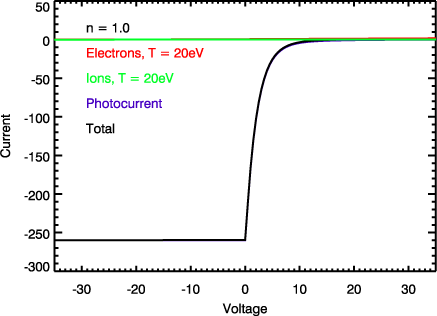
Online Help
Main
Basics
("EFW for
dummies")
Validation
Pitfalls
EFW for Dummies
1. Hardware
2. Spheres
3. Iv curve
4. Current biasing
5. Modes
Related
EFW Home
Operations
|
4. Current Biasing
So the floating potential is a function of the density and the temperature.
Well, that shouldn't be a problem, right? As long as the 2 probes
are at the same potential with respect to the plasma around them (i.e. the
temperature and density are the same), then we should still be able to take
a differential measurement, and therefore get the electric field in the plasma.
This is fine in a dense plasma. In fact, this is what has been done
on lower-orbit missions such as Freja. Unfortunately, there's a catch
in the less-dense plasma of the magnetosphere. That catch is that at
a plasma density of 100 per cc, the IV curve looks like this:

While at 1 per cc, it looks like this:

That is, it is totally dominated by the photoelectrons. Instead of
floating at 3 V, the probes float at 17 V. Worse than that, the floating
potential varies enormously with small fluctuations in the currents. This
is clearly not a good situation for measuring electric fields. So,
what do we do? We draw a bias current.
 The
EFW instrument draws a current, called the bias current, from the probes.
The total of the plasma and photoelectron currents must then equal
the bias current (instead of zero), so the probe potential adjusts to the
operating point shown to the right (assuming a bias current of 140 nA). The
EFW instrument draws a current, called the bias current, from the probes.
The total of the plasma and photoelectron currents must then equal
the bias current (instead of zero), so the probe potential adjusts to the
operating point shown to the right (assuming a bias current of 140 nA).
This has the advantage of putting the instrument on the steep part of the
curve (i.e. the low-resistance part), even in low-density environments. Small
fluctuations in the currents (whether caused by actual changes in the plasma
or simply stray currents) then do not significantly affect the probe voltage.
The probe pairs remain stably grounded (with a small offset) to their
local plasma environment. Stray currents and plasma density fluctuations
to not show up as an electric potential drop between the satellites.
The bias current has changed a few times during the mission; values range
from 140 nA (the latest value at the time of writing) to 200 nA. Check
the operations page for further details.
|
Previous page
Up to table of contents
|



 The
EFW instrument draws a current, called the bias current, from the probes.
The total of the plasma and photoelectron currents must then equal
the bias current (instead of zero), so the probe potential adjusts to the
operating point shown to the right (assuming a bias current of 140 nA).
The
EFW instrument draws a current, called the bias current, from the probes.
The total of the plasma and photoelectron currents must then equal
the bias current (instead of zero), so the probe potential adjusts to the
operating point shown to the right (assuming a bias current of 140 nA).